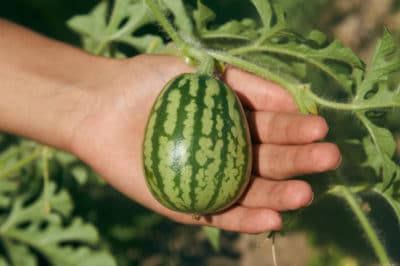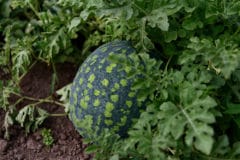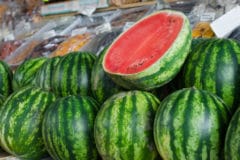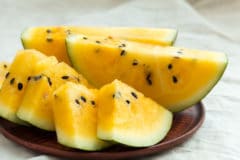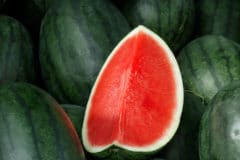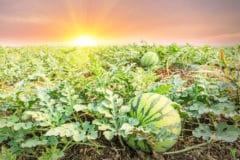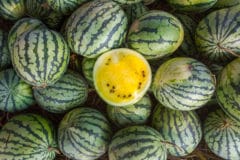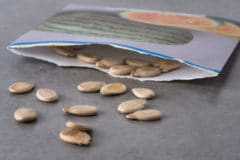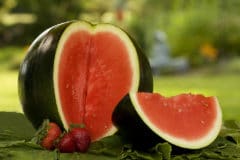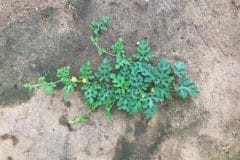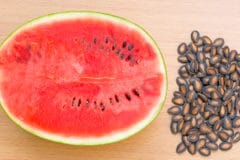Consider Your Climate First
Unless you live in a location with months and months of consistently warm temperatures, you’ll want to consider the length of your season of warmth before selecting a watermelon cultivar.
For proper germination of seeds, growth of plants, and production of fruit, watermelons perform best in temperatures ranging between 70°F and 85°F (21.1°C and 29.4°C), but still handle temperatures of 90°F (32.2°C). They are very sensitive to cold temperatures.
Once you figure out how many months your area experiences the melon’s desired temperatures, you can better select a watermelon variety that’s appropriate for your growing season. You don’t want to grow a variety that takes over 100 days to ripen when your season only guarantees 75 days.
Getting to Know Your Melon
After you know the length of your growing season, the fun begins and you can pick out a watermelon suited to your conditions and taste. You can generally find a variety of different watermelon seeds suited for your particular climate at your local garden center or home improvement store.
However, if you’re looking to grow something a bit different, online seed companies offer a wealth of selections. You can find everything from small, icebox-sized watermelons, to those weighing over a hundred pounds, as well as cultivars with orange, yellow or pink flesh.
Seed Packet Growing Information
The first clue in knowing how long you can expect your watermelon to grow before it’s ready for harvesting is held on the seed packet. Along with the melon’s description and other information, the back of the seed packet is where you’ll generally find “days to harvest” listed. This tells you how many days you can expect to wait from planting to picking.
Knowing the expected days to harvest is important when selecting a variety for your season’s length, and is a good indicator of the length of time your watermelon needs to grow before you can safely harvest. Once picked, an unripe watermelon won’t ripen.
Other important growing information contained on the seed packet include:
- Days to germination
- Depth to sow seeds
- Spacing between plants
- Row spacing
Average Growing Time
When it comes to the amount of time for watermelon seeds to germinate, it depends on the temperature.
- The best temperatures for germination are between 70°F to 95°F (21.1°C to 35°C). Germination occurs in a couple of days, when seeds are planted in 95°F (35°C) and can take a week, when planted in 70°F (21.1°C).
On average and depending on your particular watermelon’s expected days to harvest, plants start blooming in around five to six weeks. However, male flowers generally bloom a week or so before the female flowers appear and don’t be concerned if the males drop.
Once the flowers are pollinated, it takes around 45 days for the watermelons to be ready for harvesting. Of course, if you are growing a variety that takes around 60 days from planting to picking, the growth cycle will be a bit shorter.
Expert Tip: You can get a head start on growing your watermelons by starting the seeds indoors two to three weeks before planting outdoors. Grow the seedlings in peat pots so the melon’s sensitive roots aren’t disturbed when planted.
Choices Based on Growing Time
Gardeners have a wealth of choices in watermelons based on their days to harvest. Even those living in cooler climates have a variety of selections that are perfect for shorter seasons. Whether you are looking for a melon that ripens in 60 days or one that takes over 100 days to achieve ripeness, there something for everyone.
Some examples include:
- ‘Sweet Dakota Rose’ an heirloom, produces 10- to 20-pound, bright red-fleshed fruits. Good for shorter seasons as it matures in around 60 days.
- ‘Yellow Alice’ is a Korean hybrid producing small, round fruits with yellow-flesh. Matures in 55 to 60 days.
- ‘Strawberry’ is a hybrid producing sprawling vines and 15- to 20-pound, strawberry red-fleshed fruit with dark green striped skin. Matures in 85 days and disease-resistant.
- ‘Compadre’ is a disease-resistant hybrid producing 20- to 25-pound, red-fleshed and oval fruits. Matures in 82 to 85 days.
- ‘Bush Snakeskin’ produces shorter vines and 25- to 45-pound, red-fleshed fruits and is disease-resistant. Matures in 100 to 110 days.
- ‘Carolina Cross’ bears 200-pound, red-fleshed fruit with green-striped skin. Matures in around 100 days.
Signs it’s Time to Harvest
Now that you’ve spent so many months waiting for your watermelons to ripen, make sure you know the signs that it’s ready for harvesting.
- The curly tendrils on the stem where attached to the watermelon change from light-green to brown and become dry.
- The watermelon’s appearance changes from shiny to dull.
- You can’t penetrate the outer skin with a thumbnail.
- The bottom portion of the melon that touched the ground changes from green to yellowish.
- The heavier the watermelon, the riper it is.
Once you’ve determined your watermelon has achieved the stage or ripeness, use a sharp knife or pruning snips to cut the melon off the attached vine. You can now enjoy the sweet and juicy fruits of your labor.
